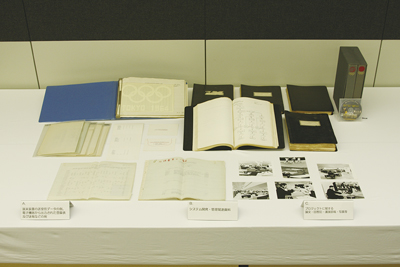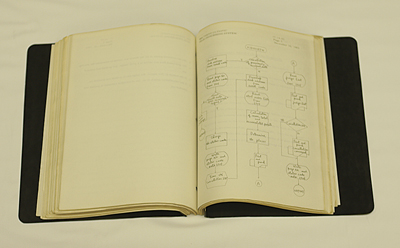

- Home >
- Artifacts of IP Heritage >
- 2012 >
- Related materials of the Tokyo Olympic information system
Related materials of the Tokyo Olympic information system


| Manufactured in | 1964 and others |
|---|---|
| Manufactured by | IBM Japan,Ltd. and others |
| Owner | IBM Japan,Ltd. |
| Location of historical materials | IBM Japan,Ltd. 19-21,Nihonbashi Hakozaki-cho,Chuo-ku,Tokyo 103-8510 Japan |
| Visitor information | Not open to the public (visit by appointment only) |
| Contact | Yohei Kawakami: Yohei.Kawakami1@ibm.com |
An on-line information system, which was the first of its kind in Japan, was used for the 1964 Tokyo Olympic Games. The computer complex consisted of eight machines, and its nucleus was a dual system, each subsystem of which was a direct couple of a small-sized data-processing machine (used mainly for data transmission and verification) and a medium-sized one (primarily for compiling result reports). Two magnetic disks were shared for back-up and recovery.
Public digital data transmission by NTT was not available yet, and there was no experience in on-line processing in this country at that time. The project faced many Japan firsts, nevertheless a number of creative ideas and breakthroughs enabled the accomplishment of the large-scale undertaking, including control programs with fallout recovery capability to provide speedy and accurate information service for the Games. The Master Record Book, containing all the competitions’ reports, was generated before the closing ceremony. To improve the development productivity, efficiency, and quality, extensive standardization, code-sharing, and documentation were implemented.
The success of this project helped promote the installation of the on-line information systems in Japan, and contributed to the advancement of computer programming and to software development by team efforts. Included in the heritage are the final products (registration lists, a large variety of result reports, etc.), intermediate products (design specifications, document control listings, progress control charts, etc.), and the final project report as well as newspaper articles, photos and technical papers on the software development. These are considered to be valuable assets for identifying and understanding the software development technologies in the earliest days of the online information processing in this country.
Public digital data transmission by NTT was not available yet, and there was no experience in on-line processing in this country at that time. The project faced many Japan firsts, nevertheless a number of creative ideas and breakthroughs enabled the accomplishment of the large-scale undertaking, including control programs with fallout recovery capability to provide speedy and accurate information service for the Games. The Master Record Book, containing all the competitions’ reports, was generated before the closing ceremony. To improve the development productivity, efficiency, and quality, extensive standardization, code-sharing, and documentation were implemented.
The success of this project helped promote the installation of the on-line information systems in Japan, and contributed to the advancement of computer programming and to software development by team efforts. Included in the heritage are the final products (registration lists, a large variety of result reports, etc.), intermediate products (design specifications, document control listings, progress control charts, etc.), and the final project report as well as newspaper articles, photos and technical papers on the software development. These are considered to be valuable assets for identifying and understanding the software development technologies in the earliest days of the online information processing in this country.
